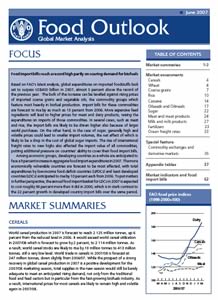 |
|||||||||
|
|||||||||||||||||||
|
|
FAO
Forecasts Continued High Cereal Prices Global cereal prices are expected to remain at high levels for the coming year due largely to problems in production in several major exporting countries and very low world stocks, warns the latest Food Outlook report issued this week by FAO in London.
FAO expects many countries will pay more for importing cereals from world markets than they did in previous years, even though they are expected to import less. Record freight rates and high export prices are the main reasons for the increase in their import bills. FAO’s latest analysis suggests that international cereal prices are fuelling domestic food inflation in many parts of the world. For most cereals, says the report, “supplies are much tighter than in recent years while demand is rising for food as well as feed and industrial use. Stocks, which were already low at the start of the season, are likely to remain equally low because global cereal production may only be sufficient to meet expected world utilization.” The report says that while agricultural commodity prices rose sharply in 2006, in some cases they are soaring at an even faster pace this year. Prices increasing for most all food commodities According to Food Outlook, the current state of agricultural markets is distinguished by increasing world prices of nearly all major food and feed commodities. High international prices for food crops such as grains continue to ripple through the food supply chain, contributing to a rise in retail prices of such basic foods as bread or pasta, meat and milk. According to the FAO analysis, the world has rarely felt “such a widespread and commonly shared concern about food price inflation, a fear which is fuelling debates about the future direction of agricultural commodity prices in importing as well as exporting countries, be they rich or poor.” The growing impact of biofuels on food availability and prices Soaring petroleum prices have driven up prices for agricultural crops by raising input costs and by boosting demand for those crops used to produce biofuels. Food Outlook warns that the combination of high petroleum prices and the desire to address environmental issues is likely to boost demand for feedstocks, especially sugar, maize, rapeseed, soybean, palm oil and other oilcrops as well as wheat for years to come. Rising cost of shipping adds to food costs Increased fuel costs, stretched shipping capacity, port congestion and longer trade routes have pushed up shipping costs, making freight rates a more important factor in agricultural markets than in the past. According to Food Outlook, record freight prices not only increased the cost of transportation, they have also changed the geographical pattern of trade, as many countries are sourcing their imports from suppliers closer to home to save on transport costs. Weak US dollar lessens impact of rising commodity prices The fact that the dollar depreciated sharply against all major currencies lessened the real impact of the rise in world prices in non-dollar economies. However, countries whose currencies did not strengthen will bear the full brunt of the rise in US dollar-denominated commodity prices. Going forward According to Food Outlook all indications point to more wheat being planted around the world for harvesting next year. A strong expansion in wheat production, assuming normal growth in consumption, is bound to bring down wheat prices. On other commodities Food Outlook has this to say: Maize prices hit a 10-year high in February 2007 but have fallen considerably since. Supply constraints in the face of brisk demand for biofuels triggered the initial price hike in maize prices. However, reacting to a massive expansion in plantings and expectations of a record crop this year, prices have started to come down, although by September they had still remained 30 percent above last year. Prices of barley, another important cereal, also soared lately. Supply problems in Australia and Ukraine, tighter availability of maize and other feed grains compounded with strong import demand have contributed to the doubling of prices of both feed and malting barley in recent weeks. Among all agricultural commodities, dairy products have witnessed the largest gains compared with last year, ranging from 80 percent to more than 200 percent. High feed prices have also increased the cost of animal production and resulted in an increase in livestock prices. Poultry is up most, by at least 10 percent. Growth in consumption and gradual reductions in trade restrictions are contributing to the increase in meat and poultry prices this season, says Food Outlook. Food Outlook also has a special chapter on the International Year of the Potato 2008, explaining the importance of this now ubiquitous food.
|
||||||||||||||||||

|
|
||||||||||||||||||
| home | agri-services | pedigree
pen | news | dairy | beef | machinery property | organisations | site map |
|||||||||||||||||||

